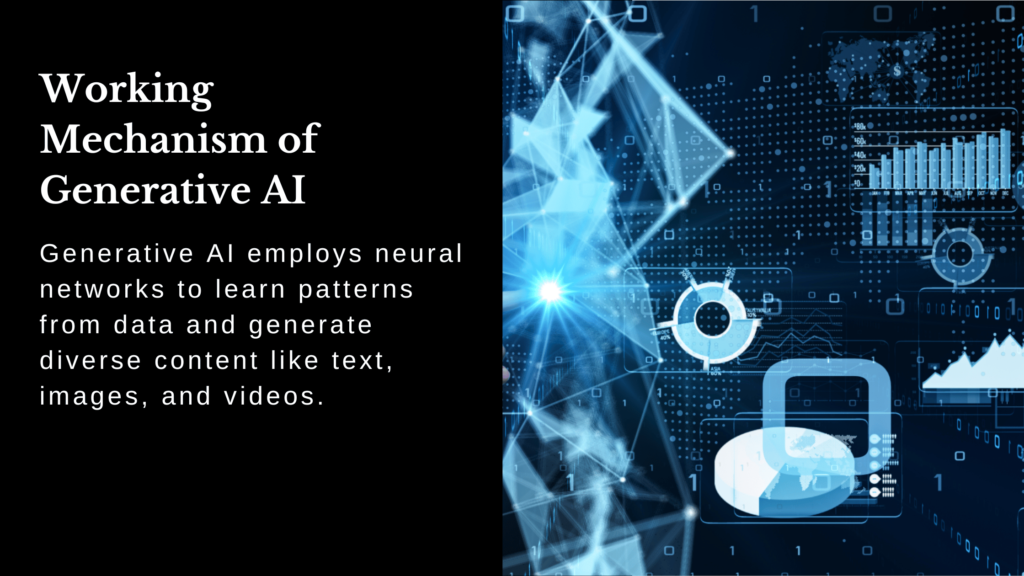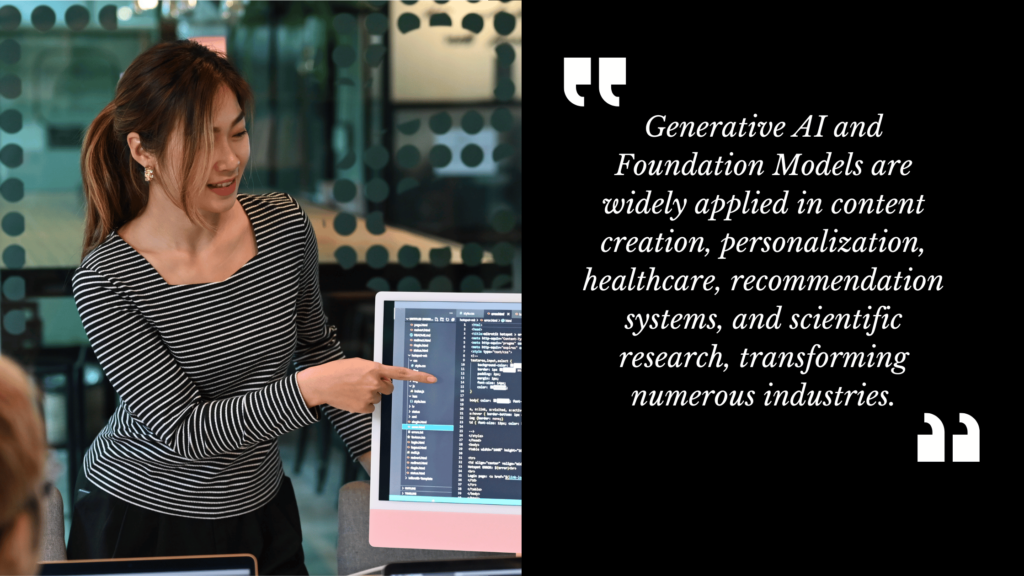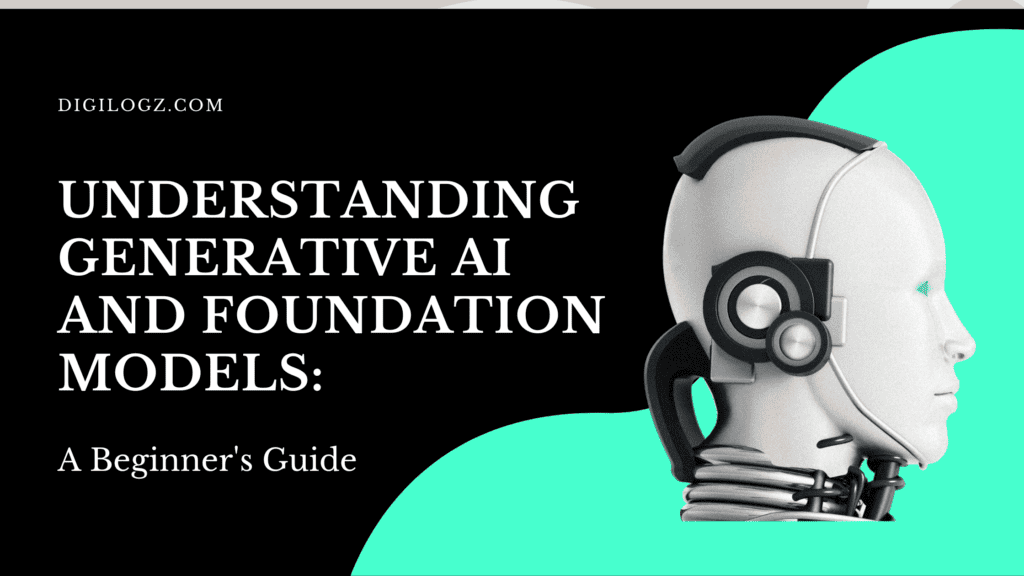Artificial Intelligence (AI) has evolved significantly in recent years, with Generative AI and Foundation Models emerging as two key areas of interest. In this beginner’s guide, we will explore the fundamentals of Generative AI and Foundation Models, their working mechanisms, applications in various domains, and future trends.
I. Introduction to Generative AI and Foundation Models
A. What is Generative AI?
Generative AI refers to a subset of artificial intelligence that focuses on creating new content, such as text, images, and videos, rather than simply analyzing existing data. It employs machine learning algorithms to generate content that resembles human-created material.
- Explanation of how Generative AI works: Generative AI algorithms, such as Generative Adversarial Networks (GANs) and transformer-based models, learn patterns from training data and generate new content based on those patterns.
- Importance of Generative AI in the field of machine learning: Generative AI opens up possibilities for automated content creation, personalization, and creativity, revolutionizing various industries.
- Applications of Generative AI in Real-world Scenarios: Generative AI finds applications in content generation, music composition, art creation, and more, contributing to advancements in creative industries and beyond.
B. Overview of Foundation Models
Foundation Models are AI neural networks trained on massive datasets to handle a wide variety of tasks. Examples include GPT-3 and BERT.
- Definition and purpose of Foundation Models: Foundation Models serve as versatile frameworks that can be adapted to various tasks without extensive retraining.
- Key characteristics of Foundation Models: These models are trained on large-scale datasets using unsupervised learning, enabling them to understand complex patterns and relationships in data.
- Examples of popular Foundation Models: GPT-3, developed by OpenAI, and BERT, developed by Google, are among the most well-known Foundation Models.
C. Relationship between Generative AI and Foundation Models
Generative AI often relies on Foundation Models for content generation tasks due to their versatility and adaptability.
- How Generative AI leverages Foundation Models for generating content: Generative AI algorithms utilize the knowledge learned by Foundation Models to generate realistic and diverse outputs.
- Advantages of using Foundation Models in generative tasks: Foundation Models provide a solid framework for Generative AI, enabling efficient content generation across different domains.
- Challenges and limitations of working with large Foundation Models: While Foundation Models offer significant benefits, they also pose challenges such as high computational requirements and potential biases in the training data.
II. Understanding the Working Mechanism of Generative AI

A. Neural Networks in Generative AI
Neural networks play a crucial role in Generative AI by learning patterns from data and generating new content based on those patterns.
- Explanation of neural networks in the context of Generative AI: Neural networks consist of interconnected nodes that mimic the functioning of the human brain, enabling them to learn complex patterns and relationships in data.
- Types of neural networks used in generative tasks: GANs, recurrent neural networks (RNNs), and transformer-based models are commonly used in Generative AI for different types of content generation tasks.
- Role of neural networks in generating diverse outputs: Neural networks enable Generative AI models to produce diverse and realistic outputs by learning from large-scale datasets.
B. Training Data and Algorithms
Training data and algorithms are critical components of Generative AI models, influencing their performance and output quality.
- Importance of training data in Generative AI models: High-quality training data is essential for training Generative AI models to generate accurate and relevant content.
- Popular algorithms used in training generative models: Algorithms such as backpropagation, gradient descent, and reinforcement learning are commonly used in training Generative AI models.
- Strategies for enhancing the performance of Generative AI models through data and algorithms: Data augmentation, regularization techniques, and ensemble learning are some strategies used to improve the performance of Generative AI models.
C. Evaluation Metrics in Generative AI
Evaluating the performance of Generative AI models is essential for assessing their quality and effectiveness.
- Metrics used to evaluate the quality of generative outputs: Metrics such as perplexity, BLEU score, and FID score are commonly used to evaluate the quality of generated content.
- Challenges in assessing the performance of Generative AI models: Evaluating the performance of Generative AI models is challenging due to the subjective nature of content generation and the lack of ground truth data.
- Strategies for improving evaluation processes in generative tasks: Developing standardized evaluation metrics, conducting human evaluations, and incorporating feedback loops are some strategies for improving the evaluation of Generative AI models.
Evaluation Metrics in Generative AI
| Metric | Description |
| Perplexity | Measure of how well a probability distribution predicts a sample. Lower perplexity indicates better performance. |
| BLEU Score | Metric used for evaluating the quality of machine-translated text by comparing it to reference translations. |
| FID Score | Fréchet Inception Distance measures the similarity between generated and real images based on features extracted from a pre-trained neural network. Lower FID scores indicate better image quality. |
III. Applications of Generative AI and Foundation Models

A. Content Creation and Generation
Generative AI and Foundation Models find extensive applications in content creation across various domains.
- Role of Generative AI in creating written content, images, and videos: Generative AI enables automated content generation, allowing businesses and individuals to create large volumes of content quickly and efficiently.
- Examples of successful applications of Generative AI in content generation: ChatGPT, Jasper Chat, and Google Bard are examples of Generative AI models that have been successful in generating written content, chat conversations, and music compositions, respectively.
- Ethical considerations in using Generative AI for content creation: Ensuring transparency, fairness, and accountability in Generative AI systems is essential to mitigate the risk of producing biased or misleading content.
B. Personalization and Recommendation Systems
Generative AI plays a crucial role in enhancing personalization in recommendation systems, leading to more tailored and relevant recommendations for users.
- How Generative AI enhances personalization in recommendation systems: Generative AI algorithms analyze user preferences and behavior to generate personalized recommendations for products, services, and content.
- Case studies of personalized recommendation systems powered by Generative AI: Platforms such as Netflix, Amazon, and Spotify leverage Generative AI to deliver personalized recommendations based on user preferences, viewing history, and social interactions.
- Challenges in implementing Generative AI for personalized recommendations: Balancing personalization with user privacy, ensuring diversity and serendipity in recommendations, and addressing algorithmic biases are some challenges in implementing Generative AI for personalized recommendations.
C. Healthcare and Scientific Research
Generative AI and Foundation Models are making significant contributions to healthcare diagnostics, drug discovery, and scientific research.
- Impact of Generative AI in healthcare diagnostics and drug discovery: Generative AI algorithms analyze medical imaging data, genomic sequences, and clinical records to assist in disease diagnosis, drug development, and treatment planning.
- Examples of Generative AI models used in scientific research: Models such as AlphaFold, developed by DeepMind, have demonstrated remarkable accuracy in predicting protein structures, aiding in drug discovery and protein engineering.
- Future prospects of using Generative AI in healthcare and research domains: Generative AI holds promise for accelerating medical research, enabling personalized medicine, and improving patient outcomes through advanced diagnostics and therapeutic interventions.
Examples of Generative AI Applications:
| Application | Description | Examples |
| Content Generation | Automated creation of text, images, and videos using Generative AI algorithms. | ChatGPT, Jasper Chat, Google Bard |
| Music Creation | Generation of original music compositions for various projects and purposes. | Soundful, Amper Music, AIVA |
| 3D Modeling | Development of digital models resembling physical objects for industries like entertainment and architecture. | Alpha3D, 3DFY.ai |
| Video Creation and Editing | Utilization of Generative AI for flexible video creation and editing processes. | Descript, Xpression, Synthesia |
| Game Development | Use of Generative AI to create game levels, objects, characters, and narratives. | Unity Machine Learning Agents, Charisma AI |
| Chatbots and Virtual Assistants | Development of chatbots and virtual assistants for customer service and task automation. | Siri, Google Assistant |
| Image Creation and Editing | Transformation of text into images with diverse settings, subjects, and styles. | (Not specified in the text, but examples could include DeepDream, DALL-E) |
| Code Generation | Automated generation of code for applications without manual input. | OpenAI Codex, GitHub Copilot, GPT-3 |
| Art Creation | Production of original artworks without human intervention. | DALL-E 2, Nightcafe |
| Voice Generation | Creation of realistic audio speech for various applications like advertising and education. | Replica Studios, Lovo, Synthesys |
IV. Future Developments and Trends in Generative AI
A. Advancements in Generative Models
Ongoing research and development in Generative AI are driving advancements in generative models and their applications.
- Current trends in Generative AI research and development: Research areas such as few-shot learning, multimodal learning, and self-supervised learning are shaping the future of Generative AI.
- Potential applications of upcoming generative models: Future generative models may enable more realistic and diverse content generation, facilitate human-AI collaboration, and support creative endeavors across various domains.
- Challenges and opportunities in adopting new Generative AI technologies: Addressing ethical concerns, mitigating algorithmic biases, and ensuring robustness and reliability are key challenges in adopting new Generative AI technologies.
B. Ethical and Social Implications
As Generative AI becomes more prevalent, it raises important ethical and social considerations that need to be addressed.
- Ethical considerations in deploying Generative AI systems: Ensuring transparency, fairness, and accountability in Generative AI systems is essential to mitigate the risk of producing biased or harmful content.
- Impact of Generative AI on job displacement and societal norms: Generative AI may disrupt traditional industries and job roles, leading to job displacement and reshaping societal norms around creativity and authorship.
- Strategies for ensuring responsible use of Generative AI technology: Developing ethical guidelines, implementing oversight mechanisms, and fostering collaboration between industry, academia, and policymakers are essential for ensuring responsible use of Generative AI technology.
C. Collaborative and Open-Source Initiatives
Collaborative platforms and open-source initiatives play a crucial role in advancing Generative AI research and fostering innovation.
- Role of collaborative platforms in advancing Generative AI research: Platforms such as OpenAI, Google AI, and Facebook AI Research facilitate collaboration among researchers, enabling the exchange of ideas and resources.
- Benefits of open-source initiatives for enhancing accessibility to Generative AI tools: Open-source frameworks such as TensorFlow and PyTorch provide developers with access to state-of-the-art Generative AI tools and resources, driving innovation and democratizing AI.
- Community efforts to address challenges and foster innovation in Generative AI: Online communities, conferences, and workshops provide forums for researchers and practitioners to share knowledge, collaborate on projects, and address common challenges in Generative AI.
Future Trends in Generative AI
| Trend | Description |
| Few-shot Learning | Focus on developing Generative AI models that can learn from a few examples, enabling faster adaptation to new tasks with minimal data. |
| Multimodal Learning | Integration of multiple modalities (e.g., text, images, audio) in Generative AI models for generating diverse and rich outputs. |
| Self-supervised Learning | Emphasis on Generative AI models that can learn from unlabeled data, reducing the need for annotated datasets and human supervision. |
V. FAQs
1. What are some examples of Generative AI applications?
Generative AI finds applications across various domains, including content creation, music composition, 3D modeling, video editing, game development, chatbots, image generation, code generation, art creation, and voice generation. Some popular examples include ChatGPT for text generation, Soundful for music composition, Unity Machine Learning Agents for game development, and DALL-E 2 for art creation.
2. How do Generative AI models learn from training data?
Generative AI models learn from training data by analyzing patterns and relationships within the data. During the training process, the model adjusts its parameters to minimize the difference between the generated outputs and the real data. This process involves optimizing the model’s algorithms and adjusting its parameters based on the feedback received from the training data.
3. What are the ethical considerations associated with Generative AI?
Ethical considerations in Generative AI revolve around issues such as bias in generated content, misuse of AI-generated content for malicious purposes, and the potential impact on privacy and intellectual property rights. It is essential to ensure that Generative AI systems adhere to ethical guidelines, respect user privacy, and mitigate any potential harm caused by biased or inappropriate content.
4. What role do Foundation Models play in Generative AI?
Foundation Models serve as the backbone of Generative AI, providing pre-trained neural network architectures that can be fine-tuned for specific generative tasks. These models are trained on vast amounts of unlabeled data, enabling them to learn rich representations of the underlying data distribution. Foundation Models like GPT-3 and BERT offer powerful capabilities for generating text, images, and other forms of content.
5. What are some future trends in Generative AI research and development?
Future trends in Generative AI research and development include advancements in few-shot learning, multimodal learning, and self-supervised learning. Few-shot learning focuses on developing models that can learn from limited examples, while multimodal learning integrates multiple modalities like text, images, and audio. Self-supervised learning aims to reduce the reliance on labeled data by enabling models to learn from unlabeled data, paving the way for more robust and adaptable Generative AI systems.
C. Resources for further reading and learning about Generative AI and Foundation Models
- OpenAI: https://openai.com
- Google AI: https://ai.google
- DeepMind: https://deepmind.com
In conclusion, Generative AI and Foundation Models hold immense potential to drive innovation, creativity, and societal impact across various domains. Understanding their fundamentals, applications, and implications is essential for navigating the evolving landscape of AI technology. As we continue to explore and harness the capabilities of Generative AI and Foundation Models, it is crucial to prioritize ethical considerations, foster collaboration, and promote responsible use to maximize their benefits for humanity.



